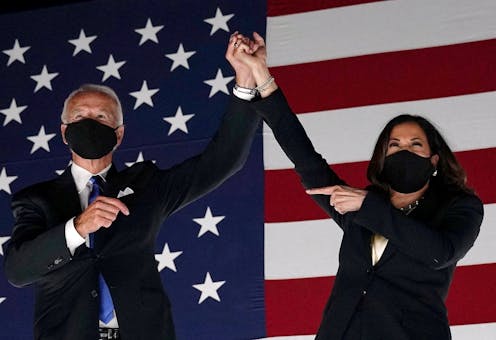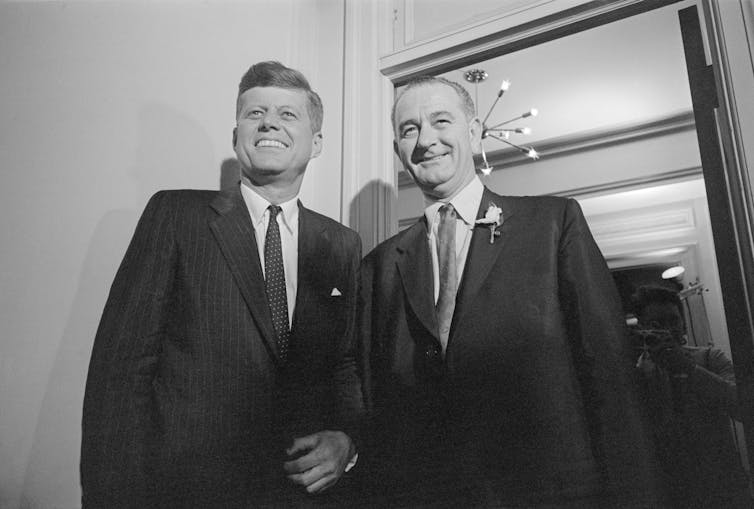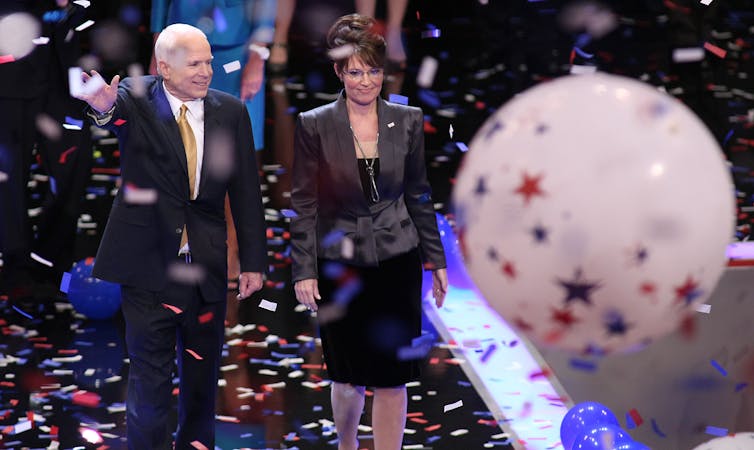Veepstakes have evolved from where you live to who you are − which way will Harris turn to balance t
From geographic balancing to making up for what the presidential candidate lacks, the considerations for picking a vice presidential candidate have changed and evolved since the 19th century.

Vice presidential picks can’t help a presidential candidate, but they can hurt one, according to political scientists. Presidential campaigns still spend a fair amount of time thinking about running mates and the ways in which they might boost the ticket – or at least not hurt it.
Who will Vice President Kamala Harris pick as her running mate, now that she appears set to be the Democratic nominee?
During the 19th and through much of the 20th century, parties picked vice president candidates who would provide the ticket with some geographic or factional balance. In many cases, those amounted to the same thing.
That approach has shifted in more recent years to selections based on experience and ideology. Those shifts have mirrored changes in U.S. politics over the decades and centuries.
Here’s a run-through of vice presidential picks since 1960 and what considerations were prominent in the choice of these running mates. As a scholar who studies American politics as well as parties and elections, my aim is to shed light on how political considerations have changed over the years, which choices may have contributed to a winning campaign – and which didn’t.

Geographic and factional balancing rises – and falls
The classic example of a geographic and factional choice for vice president was Democrat John F. Kennedy’s selection of Lyndon Johnson as his running mate in 1960. Kennedy, a liberal from the Northeast, wanted to give the ticket more appeal among conservatives and Southerners. Johnson, a U.S. senator from Texas and a favorite of the party’s conservative Southern wing, fit that role perfectly.
In 1988, Massachusetts Gov. Michael Dukakis hoped that this “Boston-Austin Axis” would work for Democrats again, leading him to pick U.S. Sen. Lloyd Bentsen of Texas as his running mate. It didn’t work, and the Dukakis-Bentsen ticket failed to catch on with voters that year.
In 1976, Democrats did the same sort of geographic and ideological balancing, but in the opposite direction. That year, Gov. Jimmy Carter, a moderate Southerner from Georgia, picked U.S. Sen. Walter Mondale, a liberal from Minnesota, as his running mate. Carter’s decision proved a wise one – he and Mondale managed to win narrowly that fall.
In recent years, as regional differences have diminished and the parties have become more ideologically unified, this type of balancing has diminished but not disappeared. For example, in 2016 Republican candidate Donald Trump, a thrice-married Manhattanite with an ambiguous ideological background, chose Mike Pence to be his running mate. Pence, then governor of Indiana, had strong appeal among conservative and evangelical Republicans in the Midwest and helped reassure those voters about Trump.
A variant of geographic balancing that still occurs is the swing state pick. By picking a running mate from a swing state, candidates hope to increase their chance of victory in a state crucial to assembling a majority in the Electoral College. Recent examples include Republican Mitt Romney’s pick of Wisconsinite Paul Ryan and Democrat Hillary Clinton’s selection of Virginian Tim Kaine.
Filling gaps
One type of balancing that is still common is using experience to balance the ticket.
When the nominee is relatively young or lacking in national political experience, they might look for a vice president with a long resume. For example, in 2000, Republicans nominated George W. Bush, then governor of Texas. Since Bush had no foreign policy experience and had never been in Congress, he chose Dick Cheney, a former member of the U.S. House and a former secretary of defense.
The same logic led Democrat Barack Obama to pick Joe Biden in 2008. By the time he got the nomination, Obama had been in the U.S. Senate for only four years and was just 47 years old. Biden, on the other hand, had been in the Senate for over 30 years, where he had served as chair of both the Judiciary and Foreign Affairs committees.
Conversely, candidates with years of experience often try to balance the ticket by picking a relatively young running mate to add a shot of youth and energy.
Examples of this include George H. W. Bush’s selection of Dan Quayle in 1988, John McCain picking Sarah Palin in 2008 and Romney selecting Ryan in 2012 on the Republican side, and Biden’s choice of Harris in 2020 for the Democratic ticket. This same generational balancing probably helped convince the 78-year-old Trump to pick 39-year-old U.S. Sen. JD Vance of Ohio as his Republican running mate this year.
Demographic differences
As American politics and society have become more diverse and inclusive, campaigns have looked for running mates that reflect those changes in the hopes of expanding the ticket’s demographic appeal.
Perhaps the first example of this was in 1984, when Democrat Walter Mondale selected U.S. Rep. Geraldine Ferraro, making her the first woman on a major party ticket. In 2008, Palin became the first woman on the GOP ticket. More recently, Harris became the first Black woman and the first person of South Asian descent to run for vice president.
The reverse of this is when a party nominates a presidential candidate from a previously unrepresented group. In those cases, putting a white man on the ticket was seen as helping to reassure more traditional voters. Thus, Obama chose Biden in 2008 and Hillary Clinton chose Kaine in 2016.

Doubling down
A final category of running mates rejects balancing and instead reflects a choice to stress the attributes of the presidential nominee.
The first example of this was in 1992. Conventional wisdom suggested that Bill Clinton, the young, moderate governor of Arkansas, should pick someone with Washington, D.C., and foreign policy experience who could appeal to the Democratic Party’s liberal wing.
Instead, Clinton chose to double down on his own characteristics in order to emphasize that he was a “different kind of Democrat” by picking Tennessee U.S. Sen. Al Gore, another young, moderate Southerner like him.
Trump’s choice of Vance is the most recent example of the “double down” strategy. Trump rejected more established conservative Republican figures such as Florida U.S. Sen. Marco Rubio and North Dakota Gov. Doug Burgum. Instead, he went with Vance, who shared his more nationalist and populist vision for the GOP.
Harris: Safe or bold?
In which direction will Harris go?
As a woman of Black and South Asian descent, the safest route for Harris would be to balance things out with a more conventional running mate, much as Obama and Clinton did during their campaigns. The possibilities here include candidates such as Kentucky Gov. Andy Beshear or North Carolina Gov. Roy Cooper.
A bolder strategy would be for Harris to double down by picking someone other than a white male in the hopes of energizing the base of the Democratic Party as well as helping to mobilize groups such as young voters or communities of color. Candidates in this category might include Michigan Gov. Gretchen Whitmer, U.S. Sen. Cory Booker of New Jersey or New Mexico Gov. Michelle Lujan Grisham.
Whether Harris decides to play it safe or go bold with her pick, the most important consideration is to do no harm.
While political scientists have found little evidence that vice presidential candidates help their tickets, a bad pick can hurt the ticket.
With a bad pick, the issue isn’t whether the ticket is sufficiently balanced or diverse, it’s whether the vice presidential candidate is adequately vetted. The worst picks – Tom Eagleton in 1972, Quayle in 1988 and Palin in 2008 – resulted from hasty and poorly thought out selection processes.
Given the rushed nature of her own candidacy, Harris’ most important task is to make sure her vice president pick receives adequate scrutiny.
Philip Klinkner does not work for, consult, own shares in or receive funding from any company or organization that would benefit from this article, and has disclosed no relevant affiliations beyond their academic appointment.
Read These Next
Who thinks Republicans will suffer in the 2026 midterms? Republican members of Congress
The president’s party almost always loses seats in the midterms. More than two dozen Republican House…
Deepfakes leveled up in 2025 – here’s what’s coming next
After a year of fast advances, deepfakes are entering a new era defined by real-time interaction with…
West Antarctica’s history of rapid melting foretells sudden shifts in continent’s ‘catastrophic’ geo
A picture of what West Antarctica looked like when its ice sheet melted in the past can offer insight…






